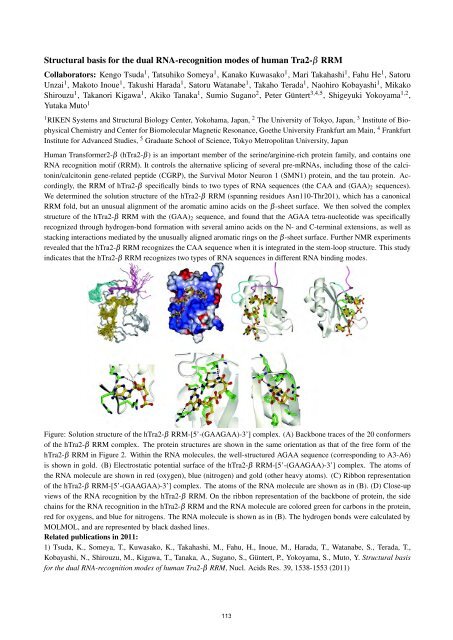FIAS Scientific Report 2011 - Frankfurt Institute for Advanced Studies ...
FIAS Scientific Report 2011 - Frankfurt Institute for Advanced Studies ...
FIAS Scientific Report 2011 - Frankfurt Institute for Advanced Studies ...
Create successful ePaper yourself
Turn your PDF publications into a flip-book with our unique Google optimized e-Paper software.
Structural basis <strong>for</strong> the dual RNA-recognition modes of human Tra2-β RRM<br />
Collaborators: Kengo Tsuda 1 , Tatsuhiko Someya 1 , Kanako Kuwasako 1 , Mari Takahashi 1 , Fahu He 1 , Satoru<br />
Unzai 1 , Makoto Inoue 1 , Takushi Harada 1 , Satoru Watanabe 1 , Takaho Terada 1 , Naohiro Kobayashi 1 , Mikako<br />
Shirouzu 1 , Takanori Kigawa 1 , Akiko Tanaka 1 , Sumio Sugano 2 , Peter Güntert 3,4,5 , Shigeyuki Yokoyama 1,2 ,<br />
Yutaka Muto 1<br />
1 RIKEN Systems and Structural Biology Center, Yokohama, Japan, 2 The University of Tokyo, Japan, 3 <strong>Institute</strong> of Biophysical<br />
Chemistry and Center <strong>for</strong> Biomolecular Magnetic Resonance, Goethe University <strong>Frankfurt</strong> am Main, 4 <strong>Frankfurt</strong><br />
<strong>Institute</strong> <strong>for</strong> <strong>Advanced</strong> <strong>Studies</strong>, 5 Graduate School of Science, Tokyo Metropolitan University, Japan<br />
Human Trans<strong>for</strong>mer2-β (hTra2-β) is an important member of the serine/arginine-rich protein family, and contains one<br />
RNA recognition motif (RRM). It controls the alternative splicing of several pre-mRNAs, including those of the calcitonin/calcitonin<br />
gene-related peptide (CGRP), the Survival Motor Neuron 1 (SMN1) protein, and the tau protein. Accordingly,<br />
the RRM of hTra2-β specifically binds to two types of RNA sequences (the CAA and (GAA)2 sequences).<br />
We determined the solution structure of the hTra2-β RRM (spanning residues Asn110-Thr201), which has a canonical<br />
RRM fold, but an unusual alignment of the aromatic amino acids on the β-sheet surface. We then solved the complex<br />
structure of the hTra2-β RRM with the (GAA)2 sequence, and found that the AGAA tetra-nucleotide was specifically<br />
recognized through hydrogen-bond <strong>for</strong>mation with several amino acids on the N- and C-terminal extensions, as well as<br />
stacking interactions mediated by the unusually aligned aromatic rings on the β-sheet surface. Further NMR experiments<br />
revealed that the hTra2-β RRM recognizes the CAA sequence when it is integrated in the stem-loop structure. This study<br />
indicates that the hTra2-β RRM recognizes two types of RNA sequences in different RNA binding modes.<br />
Figure: Solution structure of the hTra2-β RRM-[5’-(GAAGAA)-3’] complex. (A) Backbone traces of the 20 con<strong>for</strong>mers<br />
of the hTra2-β RRM complex. The protein structures are shown in the same orientation as that of the free <strong>for</strong>m of the<br />
hTra2-β RRM in Figure 2. Within the RNA molecules, the well-structured AGAA sequence (corresponding to A3-A6)<br />
is shown in gold. (B) Electrostatic potential surface of the hTra2-β RRM-[5’-(GAAGAA)-3’] complex. The atoms of<br />
the RNA molecule are shown in red (oxygen), blue (nitrogen) and gold (other heavy atoms). (C) Ribbon representation<br />
of the hTra2-β RRM-[5’-(GAAGAA)-3’] complex. The atoms of the RNA molecule are shown as in (B). (D) Close-up<br />
views of the RNA recognition by the hTra2-β RRM. On the ribbon representation of the backbone of protein, the side<br />
chains <strong>for</strong> the RNA recognition in the hTra2-β RRM and the RNA molecule are colored green <strong>for</strong> carbons in the protein,<br />
red <strong>for</strong> oxygens, and blue <strong>for</strong> nitrogens. The RNA molecule is shown as in (B). The hydrogen bonds were calculated by<br />
MOLMOL, and are represented by black dashed lines.<br />
Related publications in <strong>2011</strong>:<br />
1) Tsuda, K., Someya, T., Kuwasako, K., Takahashi, M., Fahu, H., Inoue, M., Harada, T., Watanabe, S., Terada, T.,<br />
Kobayashi, N., Shirouzu, M., Kigawa, T., Tanaka, A., Sugano, S., Güntert, P., Yokoyama, S., Muto, Y. Structural basis<br />
<strong>for</strong> the dual RNA-recognition modes of human Tra2-β RRM, Nucl. Acids Res. 39, 1538-1553 (<strong>2011</strong>)<br />
113
















